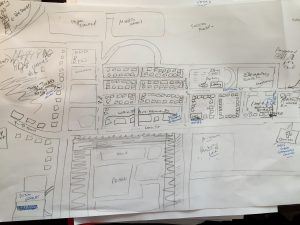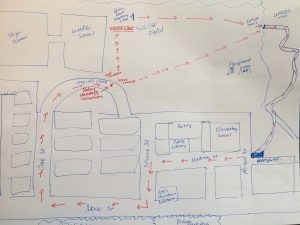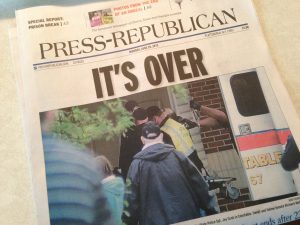The Magic of Maps
Most often, we hear the term world building as it relates to creating a fictional universe of fantasy or science fiction, but really, this is an important part of the writing process for any book with a fictional setting, including works of realistic fiction. Fictional towns need to feel real. They need all the things that actual towns have – streets and schools and shops, but also secret places where people hang out and places where you aren’t allowed to go. They need relationships between people and power structures and traditions, and I could go on and on.
One of the ways I like to wrap my head around the fictional towns in my writing is by drawing maps. Sometimes, it’s on a large scale. Here’s the (very rough!) Wolf Creek map I made when I was working on BREAKOUT. I included important places like the school, prison, library, and church as well as where my characters live. And then I added smaller details – like tree forts where the kids play and places where people worried the inmates might be hiding.

Sometimes, it’s helpful to make more specific maps to help keep track of where action is happening. Near the end of BREAKOUT, there’s a relay race, and the course is very important to the story’s plot, so I sketched out a specific map for that, too, and kept it over my desk while I was writing that scene.

The real-life manhunt in Northern New York continued while I was working on all of this. I was about fifty pages into my first draft of BREAKOUT when it finally came to an end.

The story stayed in the news for weeks, though, as I finished my draft. And then…well, then I scrapped it started over. We’ll talk about that tomorrow. Here’s today’s prompt:
Your Assignment: Make a map of your neighborhood. Think about it as a place for stories, marking not only the streets and buildings but also where things happen. Where do neighbors gather to talk on a nice day? Where have the legendary stories of your neighborhood happened?
Thanks for joining me on this part of the Breakout writing-process journey! If you’d like to read the other posts in this series once they’re all posted, you can find them here.

Buy BREAKOUT now:
- IndieBound (find a local bookseller near you!)
- The Bookstore Plus, Lake Placid, NY
- Powells
- Barnes and Noble
- Amazon





Hi, Kate! Thanks for sharing your process with us. I’m just curious. For BREAKOUT or any novel, how do you decide whether to create a fictional town for your story or to set it in a real place? What do you take into consideration when making that decision? Thanks in advance!
Hi, Sherry! Most often, I find that it works out best for me to set stories in a real region, but in a fictional town within that region. Choosing a real-world setting that’s a specific town requires a writer to pay super careful to the details of that real place, where the streets and businesses are, etc. and to be true to that, even if it’s not convenient to the plot. Wolf Creek is a fictional town that’s inspired by many of the small prison towns in Northern NY. But I didn’t choose a specific town or a real-life prison because this isn’t a true story.